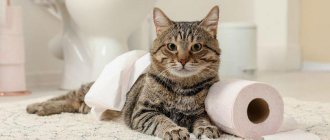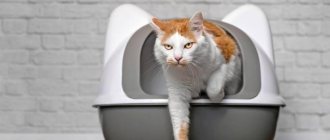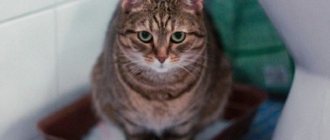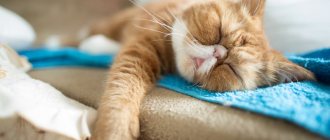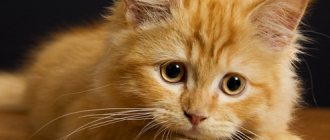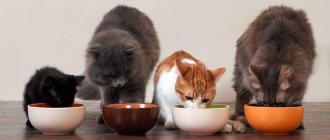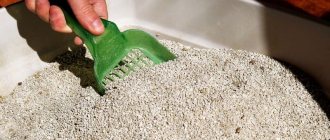Often the health of a pet depends on how attentive the owner is to changes in his behavior. Therefore, if a cat often visits the litter box but pees little, this should alert the owner.
Let's analyze the main causes of this condition, find out what pathologies are hidden behind this symptom, and what other signs of dangerous diseases of the genitourinary system are there.
Frequent urination in cats
The way a domestic cat visits the toilet is considered the main indicator of the functioning of its body. A disruption to the usual rhythm never occurs without reason. Sometimes this phenomenon may be normal, but most often urination disorders indicate pathologies.
An important sign of a pet's health is its urination pattern, namely how often and how intensely the cat urinates. According to statistics, genitourinary diseases occur in pets of any age.
The rate of metabolic processes, which changes with age, determines the characteristics of the urination regime for each specific animal.
Table 1. How many times do cats go to the toilet, normal indicators depending on age
| Age | up to 3 months | from 3 months | after 4 years |
| How often does a cat pee (per day) | 1 | 2 | 3–5 |
If the animal is dry-fed, the volume of urine decreases.
Interesting! Sterilized cats sit on the tray more often, this is a need of their body.
How you can help
First of all, in order to provide qualified assistance to your pet, it is necessary to determine the cause of frequent urination. Especially if bloody discharge is visible in the tray, you should immediately contact a veterinary clinic. Moreover, the sooner the better, since only in the first stages of the disease can a complete recovery be achieved.
You cannot make a diagnosis yourself; you must consult a veterinarian, since only a professional can prescribe qualified treatment.
To prescribe treatment, it is necessary to undergo an examination, which includes: blood and urine tests, calculation of the fluid drunk and excreted, ultrasound of the kidneys and bladder, and x-rays. Only with the help of diagnostic data can a correct diagnosis be made and treatment prescribed in accordance with it.
When a pet has problems with urination, the veterinarian usually prescribes the following medications:
- Antibiotic therapy.
- If the presence of bacteria is confirmed, sulfonamide drugs are prescribed.
- When parasites are found in the urinary tract, antiparasitic drugs are used.
- Antispasmodics that help relieve pain.
- Diuretics.
When the source of the problem is stress, then first of all you need to remove the source of stress; depending on the pet’s condition, the veterinarian may prescribe sedatives.
Reasons of a physiological nature
If a cat often goes to the toilet a little at a time, you should not immediately consider him sick. It happens that such behavior is determined by reasons that are not related to the disease:
- external influences (most often temporary);
- physiological needs of the pet.
If your cat constantly sits down to pee, you should consider whether the animal is experiencing stress. This condition can be provoked by visits from strangers, the appearance of a new animal in the house, or rough treatment.
Another sign of stress is a change in your pet's appetite. At the same time, cats’ immunity drops sharply, which means the “doors open” for the development of various inflammatory processes that require mandatory treatment.
Important! If the cat pees often and little, or eats poorly, it is necessary to analyze the situation for the presence of stress and try to eliminate the cause. If blood discharge appears in the animal's urine, you should immediately show your pet to a doctor.
In hot weather, the cat often drinks water to protect itself from overheating. Therefore, if he begins to pee frequently (6-7 times a day), there is no need to worry. He does not require treatment. As soon as the heat-related need for liquid stops, the cat will gradually stop urinating frequently and will gradually return to its normal rhythm of life.
If an adult animal likes to lie down more than run around, or is overweight, the number of visits to the litter box can be reduced to 1-2 times a day. Physically active pets go to the toilet often and little by little, while cats urinate less often than cats.
Pathological causes of frequent urination
Frequent urination is often not associated with various diseases of the genitourinary system. However, it is important for any owner to know how such pathologies manifest themselves in order to provide first aid to the animal and take it to the veterinarian in time.
Cystitis
This disease is one of the most common genitourinary diseases in domestic cats. The initial stage of the pathology has no external manifestations, but over time, inflammation of the bladder mucosa causes urination problems.
Any pet owner can recognize the signs of the disease:
- the cat often sits down to pee, but there is no urine, or it comes out in small portions;
- the animal begins to meow before urination begins, and continues to do so during the process;
- the pet often licks the perineum;
- the cat has a tense stomach and sometimes starts vomiting;
- the animal is thirsty all the time;
- urine has changed color to darker;
- the appearance of an ammonia odor from animal secretions.
Cystitis cannot be neglected, as it can become chronic. The most common causes of pathology are the animal’s lack of protein food, a small amount of fluid, infection, hypothermia, kidney inflammation, and helminthic infestation.
Expert opinion
Chepa Natalya Semenovna
Veterinarian
Ask a Question
Among cats, fold-eared breeds are most prone to otitis, because... they have a small closed ear and a narrow ear canal that is poorly ventilated. Hairless breeds produce a lot of sulfur, which can also be a predisposing factor for the development of otitis media. A common mistake owners make when caring for their ears is using a cotton swab. It will not be possible to clean the ear well with a cotton swab due to its structure, but leaving the cotton swab, “compacting” the wax inside the passage and causing irritation of the skin of the ear canal is quite likely. For home care, it is best to use special lotions no more than once a month. You should not use multi-component ear drops on your own. Medications should be prescribed by a doctor based on a cytological examination.
Urolithiasis disease
This disease most often develops in older or neutered animals. Rarely, the disease is diagnosed in young pets.
If your cat often runs to pee and his appetite has decreased, measure the animal's body temperature. Elevated levels combined with lethargy, vomiting and dark-colored urine almost certainly indicate the development of urolithiasis. Pathology is caused by:
- unhealthy diet with a predominance of foods that contain purines, calcium, phosphorus, potassium;
- flavored and canned additives from inexpensive industrial feeds;
- infectious lesions;
- excess weight;
- lack of water for drinking;
- predisposition to the disease at the genetic level.
Interesting! If your cat constantly drinks and often tries to pee but cannot, it is better to consult a medical specialist rather than determine the diagnosis yourself. The cause may be malignant neoplasms in the animal's gastrointestinal tract.
Diabetes
This disease is called "fat man's disease." Diabetes most often affects overweight pets. Their body does not cope well with the absorption of glucose, so animals instinctively try to lower its concentration with large quantities of water.
Table 2. Signs and causes of diabetes in cats
| Symptoms of the disease | What causes the disease |
| The cat often goes to the toilet in small quantities, but the amount of urine does not decrease | Stressful state |
| The animal is very thirsty, regardless of the weather | Disturbance of hormonal processes |
| The pet does not feel pain during urination (if the disease is not advanced) | Pregnancy |
| In the case of a long-term illness, the cat’s weight drops sharply, interest in games disappears, vomiting may begin, and appetite changes are observed. | Using inappropriate foods in the diet |
When diabetes develops, a cat's breath begins to smell like acetone. If such a symptom appears, it is necessary to urgently show the animal to a doctor.
Cushing's syndrome
This pathology is hormonal and is rarely diagnosed in domestic animals. To prevent possible illness, it is important to carry out preventive examinations on a regular basis.
The disease can be triggered by treating your pet with corticosteroids or a tumor in the adrenal gland or pituitary gland. Hormonal imbalances lead to impaired cortisol production, which gives rise to the development of Cushing's syndrome.
Signs of the disease:
- loss of appetite, rapid weight gain;
- thirst;
- frequent urination;
- development of apathy;
- the appearance of defects on the pet’s skin and fur.
Sometimes Cushing's syndrome develops as a result of diabetes. To establish a diagnosis, special tests are performed, urine and blood tests are performed, and the animal is given x-rays and ultrasounds.
Features of cystitis
Both male and female cats are susceptible to cystitis. But clinical manifestations in cats are much more common. This is due to anatomical features. In cats, the urethra is straight, short and wide, so salt crystals are excreted almost unhindered in the urine. In cats, the urethra is longer, has bends and narrowings, so mucus and salt plugs often appear in it, completely blocking the flow of urine (obstruction).
Neutered cats, whose genitourinary system functions differently than normal cats, are more prone to cystitis. In addition, stagnation of blood in the genitals leads to swelling, and this leads to spasms and urinary retention, stagnation in the bladder, salt loss, urolithiasis and chronic cystitis.
Sometimes, with cystitis, pets avoid using their litter box because they associate it with pain when urinating. And in some cases, the fear of the toilet remains even after complete recovery. Thus, cystitis can cause behavioral changes.
What else can cause polyuria?
On average, an adult cat produces 100–200 ml of urine per day. An aging pet has a weaker sphincter, so it cannot tolerate it all the time. An older cat goes to the toilet more often, and this is normal. At the same time, the amount of urine excreted by animals per day does not change (pollakiuria). In case of rapid progression of urinary incontinence, the animal should be shown to a specialist and treatment should be started.
During puberty, cats mark their territory and leave small portions of urine in different places. The pungent odor of such secretions often causes the animal to be castrated.
Frequent urination in this case is a completely natural need, namely the desire to claim territory. This does not indicate that your pet is sick.
If the owner feeds the pet not with natural products, but with meat pads, he will need a triple volume of liquid. Accordingly, such a cat or kitten urinates often; the processes of removing toxins and waste from its body are much more intense than in animals that eat wet food.
Sometimes the cause of polyuria in a domestic cat is kidney failure. As a rule, this happens to animals older than 8 years.
Signs of the disease:
- paleness of the nasal triangle;
- temperature drop;
- the appearance of wounds in the oral cavity and on the surface of the tongue;
- increased secretion of saliva;
- unusual odor from your pet's mouth;
- tremor of the limbs and nausea may appear.
Important! Most experts consider polyuria not an independent disease, but a symptom that indicates functional malfunctions in the body.
Diagnostics
The development of genitourinary diseases is most typical for adult animals, but if your kitten often walks around in a small way, most likely he is sick. It is necessary to urgently consult a doctor about this.
A healthy animal walks quickly and does not experience discomfort. If your cat begins to visit the toilet frequently, you should watch him.
The following are considered warning signs:
- plaintive meowing during urination;
- lethargy of the pet or unusual restlessness;
- change in the color of urine, the appearance of a pungent odor;
- the cat began to go to the toilet often;
- urine comes out in droplets.
It is difficult for a person who is not familiar with veterinary medicine to determine why his cat cannot go to bed, which is why the pet has become restless and nervous. But only in the case of hot weather can this behavior of the animal be explained by natural causes.
Unusual urinary behavior
When cats are happy and healthy, they use the litter box for both urination and defecation. Below are the behaviors of cats experiencing urinary problems due to stress or suffering from feline urological syndrome. If your pet exhibits any of the following, it may be a sign of illness:
- tension during urination;
- urinary incontinence/inability to control bladder;
- urination past the tray;
- loud meowing in pain while urinating or trying to urinate;
- licking the genital area;
- decreased appetite.
For most cats, the above signs appear when their emotional stress reaches the limit or when they have medical problems. If your cat hides, becomes less affectionate, has a change in feeding behavior, or only urinates or only defecates in the litter box, note that this behavior may be an early sign of stress. However, in some of them, signs of urological syndrome appear suddenly, without any preliminary changes in behavior. At the first signs of urological syndrome, you should contact your veterinarian to determine whether a visit to a specialist is necessary or if you can first try to solve the problem at home.
Treatment methods
As a rule, the doctor prescribes an ultrasound of the animal’s internal organs. If your cat often sits down to pee and is not thirsty, you will need to have his urine and blood tested. He may be referred for an X-ray examination.
Based on the results obtained, the doctor determines the diagnosis and prescribes individual therapy. Most often, domestic cats are treated with antibiotics, hormonal agents, and anti-inflammatory drugs. Sometimes antispasmodics and painkillers are necessary. Sometimes the only thing that can help your pet is surgery.
If tests show the formation of stones in the animal’s kidneys, the owner may be offered to operate on the cat. Later, the veterinarian prepares a special diet that excludes pathology-causing foods from the diet. During the treatment period, the cat is isolated from other pets.
